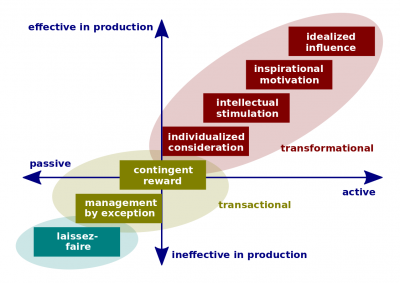Difference between revisions of "Management by exception"
| Line 1: | Line 1: | ||
| − | [[File:Leadership-styles.png|400px|thumb|right|[[Full Range Leadership Model]]]][[Management by exception]] (hereinafter, the ''Style'') is leadership style of someone who intervenes into lower level management only if financial and/or operational results substantially differ from the budgeted or expected figures. The leader who exercises the ''Style'' is considered being a type of [[transactional leader]]s. | + | [[File:Leadership-styles.png|400px|thumb|right|[[Full Range Leadership Model]]]][[Management by exception]] (hereinafter, the ''Style'') is leadership style of someone who maintains the status quo and intervenes into lower level management only if financial and/or operational results substantially differ from the budgeted or expected figures. The leader who exercises the ''Style'' is considered being a type of [[transactional leader]]s. |
Revision as of 21:30, 20 November 2018
Management by exception (hereinafter, the Style) is leadership style of someone who maintains the status quo and intervenes into lower level management only if financial and/or operational results substantially differ from the budgeted or expected figures. The leader who exercises the Style is considered being a type of transactional leaders.
Full Range Leadership Model
- Main wikipage: Full Range Leadership Model
Full Range Leadership Model. A model that depicts seven managerial leadership styles on a continuum: (1) laissez-faire, (2) management by exception, (3) contingent reward leadership, (4) individualized consideration, (5) intellectual stimulation, (6) inspirational motivation, and (7) idealized influence.
Transactional leadership
- Main wikipage: Transactional leadership
